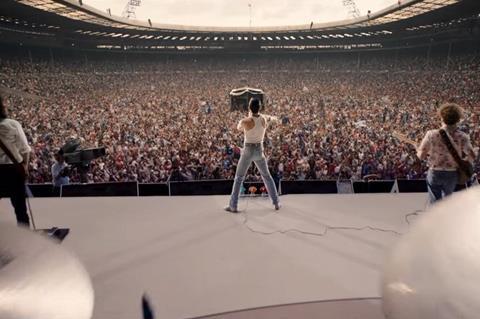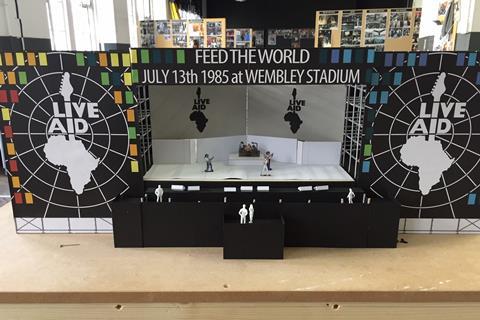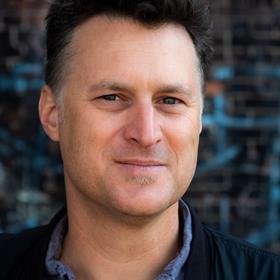The Editor and Production Designer of Freddie Mercury biopic Bohemian Rhapsody tell IBC365 how the film recreated the classic Live Aid concert from Wembley Stadium – with 800 extras at Bovingdon airfield near Hemel Hempstead.
Queen’s showstopping 21-minute gig during 1985’s Live Aid is a contender for the greatest live performance in rock music history and is “the Star Wars Death Star sequence” of a new film according to its Editor.

“It is the moment the whole movie is building towards so there was a lot of pressure to fulfil people’s expectations of what that might be,” explains John Ottman, the editor of Freddie Mercury biopic Bohemian Rhapsody. “The biggest fear making this film was whether ending at Live Aid, with no epilogue, was going to be memorable and leave people emotionally satisfied or leave them blank.”
The film has had a turbulent history as befitting its rock and roll subject. Over a decade in which a revolving door of stars (Sacha Baron Cohen and Ben Whishaw signed to play the lead) and directors (Tom Hooper and Dexter Fletcher) were attached, the final script has the blessing of the band’s guitarist Brian May and drummer Roger Taylor. The director is Bryan Singer (whose credits include most of the X-Men franchise) although Fletcher returned to direct about a third of principal photography after Singer was fired allegedly due to misconduct on set.
“The film is the classic narrative arc of alienated artist and inflated ego, who is then humbled and who finally brings the band back together for triumphal come back,” says Ottman. “We tell it in a down to earth fashion with nothing hyper real about it except for the concert pieces. These, I made a little more stylistic. I didn’t want to represent them as a straight [forward] concerts otherwise you’d risk losing sight of the story but instead to have each piece move the narrative forward.”
During the band’s first big tour of the U.S, for example, a sequence is inserted about Freddie’s visit to a truck stop bathroom. “It’s the first glimpse into his sexuality,” says Ottman. Also, in the U.S tour sequence, Mercury calls out the names of the states and cities they play as a device to speed the timeline.
While all editors will have a hand in sound design and many have musical or sound editing experience, Ottman is unusual in regularly composing the movie score as well as picture editing. He’s done this with Singer for The Usual Suspects, Apt Pupil, Superman Returns, Valkyrie, and X-Men: Days of Future Past. He’s also composed music for other directors and their films, notably The Cable Guy, Kiss Kiss Bang Bang and Fantastic Four.
“I can’t wait to finish cutting the picture because what I look forward to most is the score,” he says. “I’m always seeing the film from both sides, from the point of view of music and picture.”

Bohemian Rhapsody, though, has no score, relying instead on Queen’s extensive back catalogue although Ottman embellished the soundtrack with opera, for instance in a scene where Mercury is on the phone to his partner Mary.
“I didn’t want to have the schmaltzy track list of a typical biopic but to add some theatricality and depth,” he says. “Brian May was a great help in supplying all the original stems for the tracks so we had a lot of control over mixing it. In a few instances where we needed to replace the vocals for technical reasons we used vocals from Mark Martel [a winner of the Queen Extravaganza Live Tour auditions]. Even the band couldn’t tell the difference between Freddie and this guy.”
The film features May and Taylor’s precursor band Smile. Queen contacted lead singer Tim Staffall who lent the production multi-tracks of concert footage from 1969. Staffall and Smile also re-recorded tracks at Abbey Road for use in the film.
“As amazing as Queen’s music is they wrote it to be an interactive experience with an audience so the music doesn’t really soar until you hear the audience sing along, applaud and clap,” explains Ottman. “That took a lot of multi-track work to finesse.”
The biggest challenge, though, was recreating the ambience of Live Aid, arguably the biggest concert in rock history. Featuring reunions of Led Zeppelin, The Who and Black Sabbath with U2 at their prime, David Bowie and Wham, the worry for Queen was whether they could match the competition.
The live televised phenomenon bookends Bohemian Rhapsody and shows Mercury in his element as a great entertainer. Cinematographer Newton Thomas Sigel gave the picture a suitable epic scope by shooting with the large format ARRI Alexa 65 paired with Hasselblad Prime DNA and Prime 65-S lenses. Live Aid takes up a substantial portion of the film’s third act and the filmmakers had to battle with the studio, Fox, not to cut it down.
“I can’t wait to finish cutting the picture because what I look forward to most is the score” John Ottman, Editor
“You always tend to battle with a studio in terms of length or pacing but in this instance I had to do a Hail Mary pass to save it,” Ottman relates. “I cut sections in other areas in order to save more of the Live Aid material.”
It was here that lead Rami Malek’s (Mr Robot) performance really came into its own “as he channelled Mercury into an extraordinary rendition” of tracks including an abbreviated Bohemian Rhapsody, Radio Ga Ga, Hammer to Fall, Crazy Little Thing Called Love and the finale of We Will Rock You into We Are the Champions.
An extended version of the Live Aid sequences shot for the film is being produced for release, possibly as a Blu-ray extra.
It’s not all career highlights though. The lyrically dubious track Fat Bottomed Girls features in scenes of the band’s U.S tour. Explains Ottman, “In reality the track was released a year later but Bryan [Singer] was adamant he wanted this in because it’s such a crowd pleaser.”
Replicating Live Aid
The task of finding a space to build a replica of Wembley for Live Aid fell to Production Designer Aaron Haye. He says it was by the far film’s biggest challenge due to shooting in the UK’s autumnal weather in 2017.

“We put a lot of effort into how and where and how much of the stadium we were going to recreate,” he says. “Finding a location big enough was tough. We looked at a number of studio backlots but we figured it would be a muddy mess by the time we’d finished and with all the potential rain. Ideally, we needed an area with a hard surface.”
They located a site at Bovingdon airfield near Hemel Hempstead. “Even that wasn’t too easy since the land was split among five different owners and we were going to be straddling a number of them. We had to push a racetrack out of the way, liaise with two different farm properties and divert a weekend market.”
Working from footage and photographs taken on the day as well as the advice of several technicians and artists who were there, Haye created a miniature model of the set but admits it wasn’t entirely faithful.

“Wembley has had its layout changed several times over the years and we scoured the local council and libraries but couldn’t unearth any plans from the 1950 to the 1990s. We know how it was originally designed and we worked from photographs to make our version of the back stage.
“In reality there were a bunch of trailers behind the stadium and dressing rooms in the concourse under the venue so we hybridised it to look as if everything is connecting together. Bryan [Singer] fell in love with an airstream trailer as a visual so rather than use a corridor we go straight from trailer – as Queen’s dressing room – to the stage.”
Haye also roped in roped Serious Stages, the rigging company which had worked on Live Aid to assist in the build. Attention to detail included adding tracks marks on the stage, the exact and fairly significant height of the stage to the press section and audience, and a couple of sofas placed in the trusses off-stage where riggers had watched the original concert.
The eventual 70,000 sq ft set included reconstruction of the stage itself, the backstage and concourse areas (under Wembley) and part of Wembley Way, the approach to the stadium. The entire set was dressed in a massive tarpaulin to protect it from the weather. Set extensions, including Wembley’s iconic towers, were added as visual effects by Dneg.
Around 800 extras, outfitted in eighties summer festival costumes, filled the area between the stage and front of house mixing desk and were photographed from dozens of angles performing choreographed dance and body moves. Facility Dneg used this as a basis to digitally replicate the look and feel of 72,000 spectators.

“The concept for the design was to tell the story of Freddie’s arrival and journey to the dressing room, the band’s apprehension before the show and their walk from dressing room to stage all in one camera move.”
While that one-shot camera move was truncated in the final cut, much of the material remains.
It took three months of planning, design and build for two weeks of shooting including just six days of principal photography with the main cast.
“Rami and [the film’s] band memorised and performed Queen’s entire 20-minute five song set. “Brian May was there and he turned to me and said it had raised the hairs on the back of his head.”
- Read more Behind the scenes: Mike Leigh’s Peterloo
Oscars 2019: The winners
- 1
- 2
- 3
- 4
- 5
- 6
 Currently reading
Currently readingBehind the scenes: Bohemian Rhapsody
- 7


































1 Readers' comment